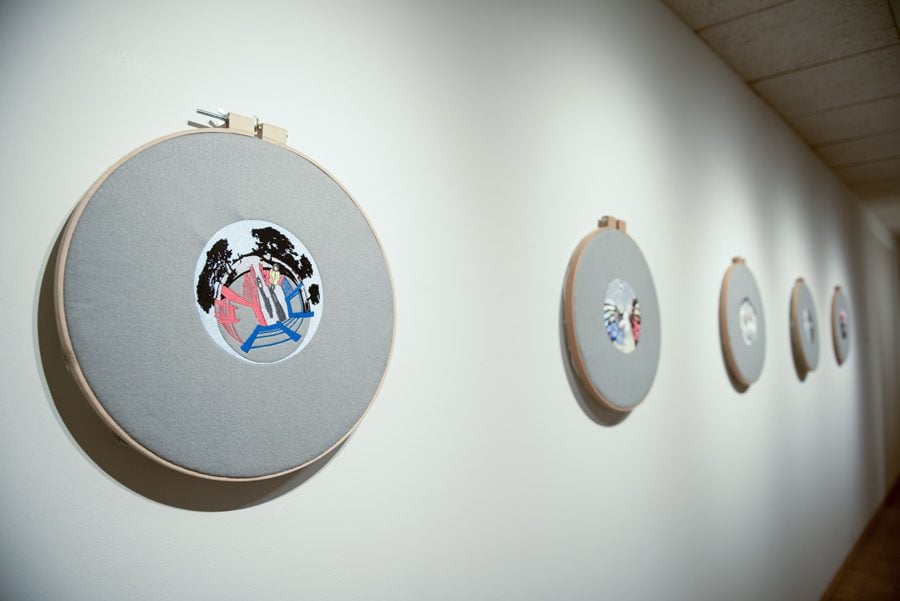Dittmar exhibit explores intimate intersections of surveillance, domestic life
Katie Pach/Daily Senior Staffer
Sabba Elahi’s art displayed at the Dittmar Gallery. Elahi, whose work explores the intersection of surveillance and domestic life, created both hand-crafted and machine-crafted embroideries.
January 24, 2018
A&E
Sabba Elahi is fascinated with drones — and not just the kind that deliver Amazon packages.
Inspired in part by U.S.-led airstrikes in Pakistan, Elahi created “Drone Stories,” her new exhibit at Dittmar Gallery exploring the intersection of war technology and domestic life. The exhibit sheds light on the government’s use of drones for war and domestic surveillance, and will run from Jan. 11 to Feb. 12.
Elahi, who expresses her art through hand and machine embroideries, quilts and wall text, said mixing different forms of media allows her to engage with a range of interconnected themes.
“It’s a way to present the complexity and range of ideas … and hopefully a way to further engage the viewer,” Elahi said. “I was attracted to machine embroideries because of how surveillance today is so high-tech.”
Elahi started the hand embroideries in 2014 and shifted to machine-crafted works in 2017. Though this involves mechanic weaving, she still creates the designs by hand, mapping the designs digitally and giving the machine a template from which to make the piece.
Her earlier, hand-crafted embroideries feature black thread on a white background with the occasional thread of green, whereas her later, machined-crafted work is much more colorful. Artist Steve Amos, who worked with Elahi at Chicago-based arts nonprofit Marwen, said he particularly likes Elahi’s injection of color into her later embroideries.
Amos said while Elahi’s new work still retains the intimacy of the hand-embroidered pieces, the mechanization of the creation echoes the mechanization of surveillance tools, such as drones.
He added that when Americans hear about surveillance and drone strikes from national media outlets, they are usually presented with statistics — many of which are “often wrong” and desensitize people. Elahi’s work, he said, adds “a face” and a story that helps viewers contextualize and humanize these issues.
“It’s much harder to ignore (her art) when that human element is added,” Amos said. “It forces you to engage with it on a deeper level.”
Elahi said the juxtaposition of cold surveillance machinery and warm, domestic scenes in her work reflects the growing sophistication of drone technology. Not only do drones give the government power to infiltrate the intimacy of the American home, but they are also now commonly used by businesses and citizens, she said.
With a fish-eye style in her embroideries, she forces the viewer to take a closer look, making it “seem like you’re peering into someone’s private world or moment.”
This intimacy is typical of her emergent works, said Ahalya Satkunaratnam, who worked with Elahi on a show commemorating the 10th anniversary of 9/11.
Satkunaratnam said Elahi’s earlier works centered on widely-circulated images, incorporating elements of newspapers and other mass media. Over time, though, she said Elahi’s images have become much more intimate.
“Over the course of time, (her art has) become much closer to home for her,” Satkunaratnam said. “It’s her at the center of this piece, in a way that makes her and makes us think about these everyday situations.”
Email: [email protected]
Twitter: @jakeholland97


